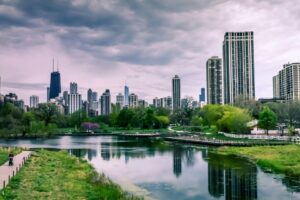Imagine living in a skyscraper where thousands of trees and plants grow on every floor, creating a natural oasis hundreds of feet above the ground. This isn’t science fiction, it’s the reality of vertical forest architecture that’s transforming cities worldwide.
The Birth of Green Skyscrapers
The concept emerged when Italian architect Stefano Boeri witnessed Dubai’s glass-covered towers reflecting intense heat onto city streets. His solution was radical: replace reflective surfaces with living vegetation. The result was Milan’s Bosco Verticale, completed in 2015, which proved that buildings could become vertical ecosystems.
How Vertical Forests Work
These innovative structures integrate thousands of plants directly into building facades. Professional gardeners, often called “flying gardeners,” maintain the vegetation using specialized harnesses. The plants naturally cool the air through evapotranspiration, reducing indoor temperatures by up to three degrees while filtering sunlight and purifying the air.
Global Expansion of Green Architecture
Following Milan’s success, vertical forests have sprouted across continents. China’s Nanjing Vertical Forest follows the original Milan principles, while the Netherlands showcases affordability with Eindhoven’s Trudo Vertical Forest offering housing at €600 monthly rent. France demonstrates social inclusion through Montpellier’s Secret Gardens, which reserves one-third of units for affordable housing. Taiwan’s capital features the striking Tao Zhu Yin Yuan with DNA-inspired architecture and rotating balconies, and Africa will soon join this movement when Cairo hosts the continent’s first vertical forest.
Scientific Benefits for Mental Health
Research from Wageningen University demonstrates that plant-rich environments significantly improve workplace satisfaction and reduce health complaints. A comprehensive Welsh study of 2.3 million medical records revealed that green surroundings reduce anxiety and depression by 40%, with the greatest benefits occurring in lower-income areas. These findings support the growing recognition that biophilic design can fundamentally transform how people experience urban living.
Climate Change Solutions
Vertical forests offer powerful environmental benefits that address multiple climate challenges simultaneously. Taipei’s Tao Zhu Yin Yuan absorbs 130 tons of CO2 annually while its natural cooling reduces air conditioning needs by 30%. Plant transpiration creates natural cooling zones that combat urban heat islands, while these buildings become habitats for birds and insects, supporting urban biodiversity. The minimized soil sealing allows better water absorption, preventing floods and supporting natural water cycles.
Healthcare Applications
Hospitals are embracing biophilic design principles. Belgium’s Hospiwood 21 uses therapeutic vertical forests to reduce patient stress and accelerate recovery. Milan’s New Policlinico Hospital will feature a 7,000-square-meter rooftop garden, transforming traditional healthcare environments into healing spaces.
Beyond Residential Buildings
The vertical forest concept extends to diverse structures:
- Singapore’s Jewel Changi features 1,400 trees and a 40-meter indoor waterfall
- Amsterdam’s Hotel Jakarta incorporates a tropical atrium garden
- Rotterdam’s Depot museum storage facility includes a rooftop forest 40 meters above ground
Future Forest Cities
Urban planners envision entire cities based on vertical forest principles. China’s Liuzhou Forest City will house 30,000 residents while generating renewable energy. Mexico’s proposed Cancun Smart Forest City plans to ban combustion vehicles entirely.
Also read: Heat-Resilient Cities: How Passive Cooling is Replacing the AC Arms Race
Benefits for Urban Dwellers
Living in vertical forests offers multiple advantages:
- Plants filter pollutants and produce oxygen
- Natural cooling reduces energy costs
- Direct access to nature reduces stress and anxiety
- Shared gardening spaces foster social connections
- Residents observe birds and wildlife in urban settings
The Future of Urban Living
Vertical forests represent more than architectural innovation – they’re a blueprint for sustainable urban development. As cities face climate challenges and mental health crises, these living buildings offer solutions that benefit both human wellbeing and environmental sustainability.
The integration of nature into vertical architecture demonstrates that urban density and environmental restoration can coexist. For city dwellers seeking healthier, more sustainable living options, vertical forests provide a compelling vision of the future where technology and nature work in harmony.










